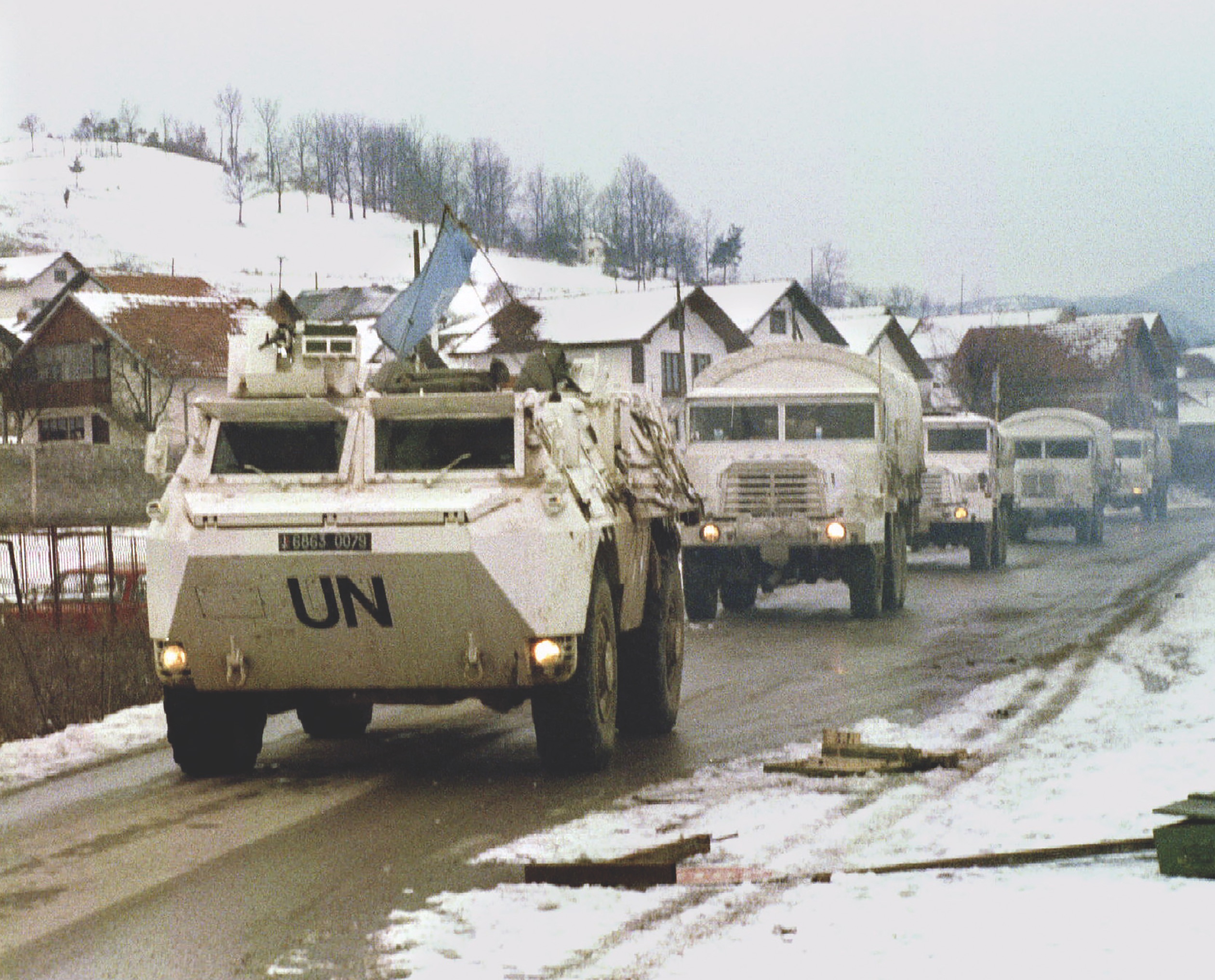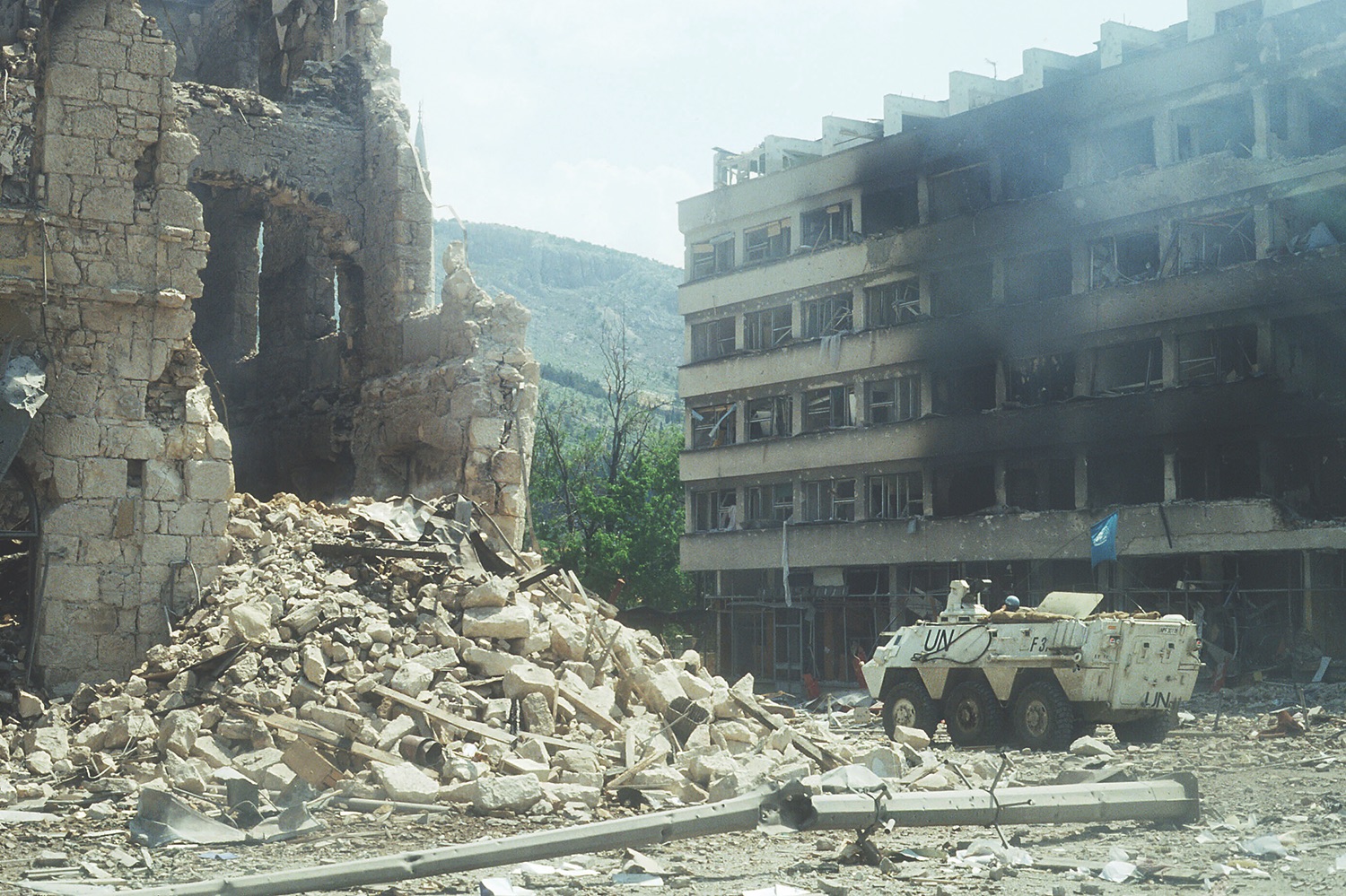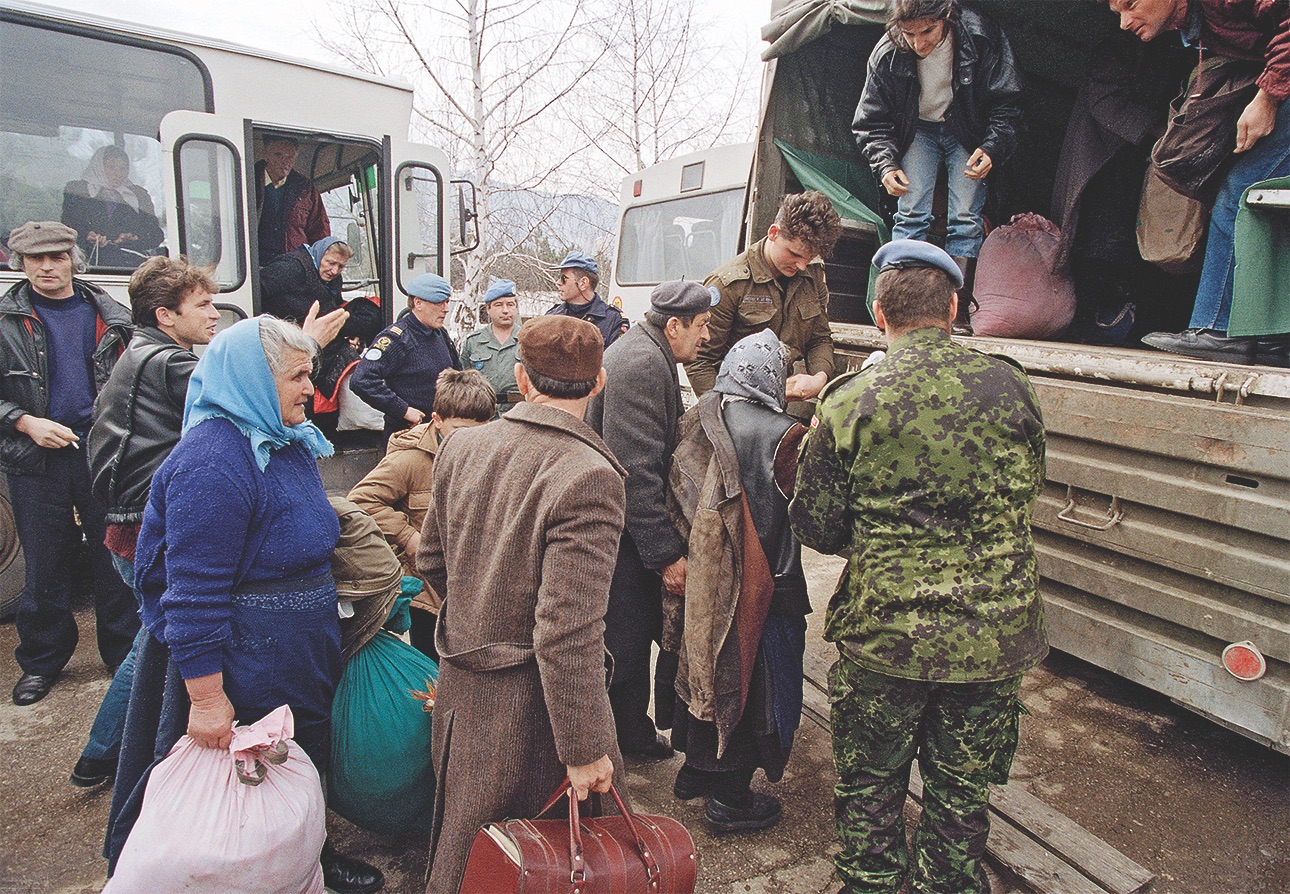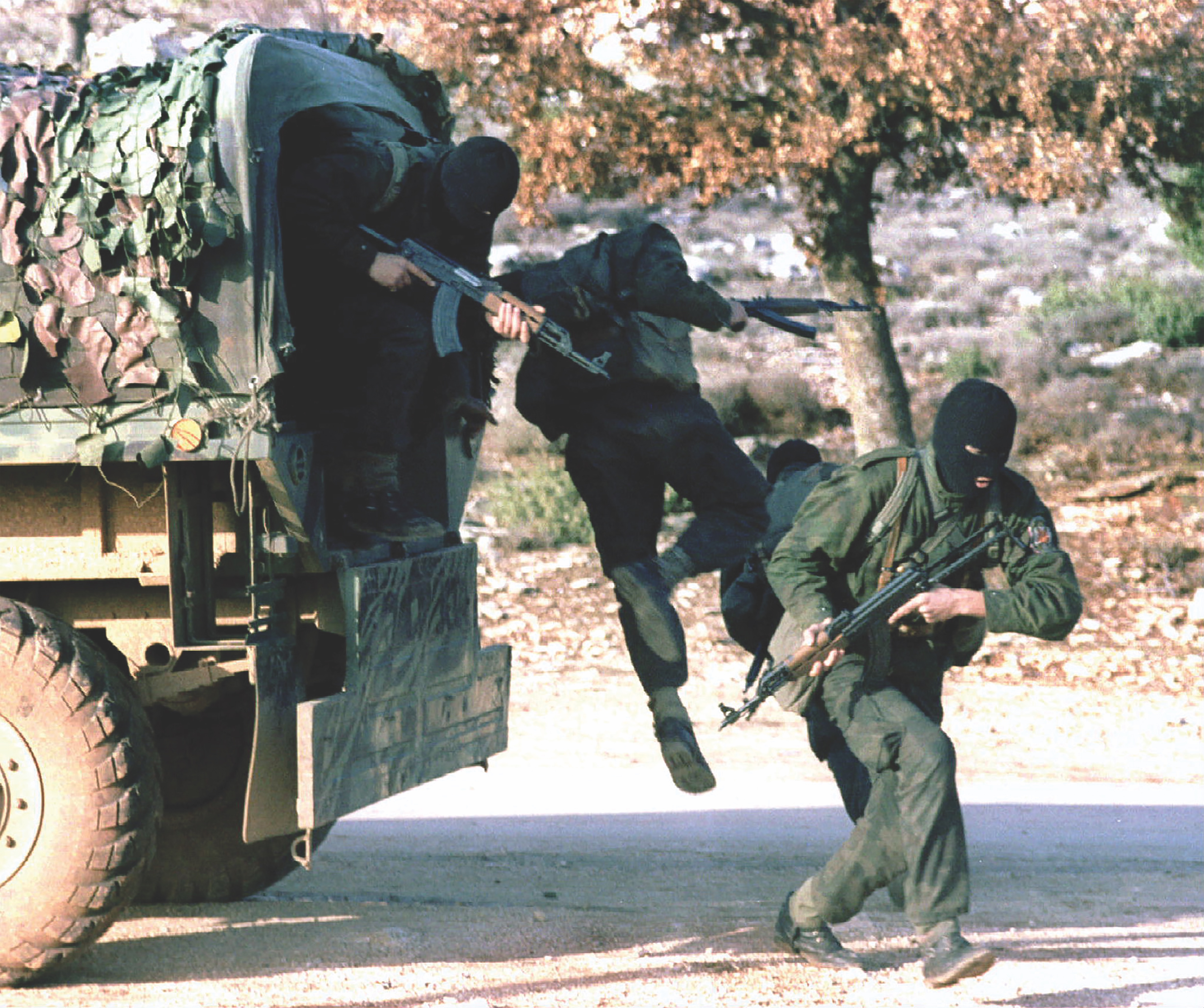It was Sept. 16, 1993, and hardly a typical press conference. No podiums and no flags, just plenty of weapons. An M113 armored personnel carrier painted U.N. white and stopped at a mined Croatian roadblock provided the backdrop, and reporters shouted their questions over the roar of a convoy of APCs idling restlessly off camera. The center of attention, Lt. Col. Jim Calvin, the commander of 2 Battalion, Princess Patricia’s Canadian Light Infantry (PPCLI), was fuming. Based on a cease-fire agreement negotiated by diplomats and politicians in Zagreb, the Croatian capital, Calvin had been tasked with inserting his troops between warring Serbian and Croatian forces near Medak, in the internationally unrecognized Krajina region of southern Croatia. He was frustrated by the Croats that were blocking his troops’ advance.
“At some stage you have to cut the bull— and get on with the job,” Calvin bluntly told the gathered news crews. “And all I’ve heard right now from the Croatian people at my level here is a bunch of half-baked excuses aimed at delaying us from getting on with the operation.”
With three M-84 tanks (the Yugoslav variant of the Soviet-era T-72) threatening in the distance, Calvin had deployed his infantrymen along the ditches and roadsides, their small arms loaded and locked, while gunners atop the M113 trained their BGM-71 TOW (tube-launched, optically tracked, wire-guided) anti-tank missile tubes on the Croatian armor. The Princess Pats were determined to fulfill their mission and prepared to do battle with the Croats if necessary. International media attention, coupled with Croatian President Franjo Tudjman’s fear of subsequent diplomatic opprobrium, ultimately won the day. Within 90 minutes the Croats had removed the roadblock, and the Canadians were rolling north.
Remarkably, only hours earlier, these same Canadians and Croats had been shooting at each other. The night before, recalled Sgt. Rod Dearing, the Canadians had done “some major damage” in the firefight—killing 27, according to initial Croatian reports. In the intervening quarter-century and with the complicity of participants on both sides of the battle, this small but significant engagement has slipped from memory.
Five years later Calvin addressed the Canadian Senate Standing Committee on National Defence and Veterans Affairs. “The Medak operation was a peace enforcement operation of 14 days’ duration that was set in the context of a broader traditional peacekeeping operation,” he explained to the senators. “On very short notice we were required to move into what was an enforcement operation, using almost the full extent of the weapons systems we had available to us to enforce the will of the United Nations.” Indeed, the Croatian mission precipitated the most intense firefight in which Canadian troops had engaged since the Korean War. Operationally, it signaled a seismic shift, as the U.N. transitioned from traditional peacekeeping into the ambiguous and inherently dangerous world of peacemaking and enforcement. Tragically, it also introduced the world to the term “ethnic cleansing.”

The Princess Pats spent the early months of their Croatian tour in the relative quiet of Sector West, but the battalion was gradually transferred to Sector South that summer. They were walking into a hornet’s nest. “Sector South was a far more volatile and demanding sector,” Calvin conceded to Canadian senators. “Open warfare was going on here. Artillery shelling was a daily occurrence. Shots were being fired. Tank fire was being fired on a daily basis.” He later admitted to a military board of inquiry, “Peace is a relative term in the former Yugoslavia—and, in fact, in 1993 it was something of a joke.”
This was the violent world the Princess Pats entered that first week of September 1993. Few understood the depth of historic hatred in the region. “The moors, valleys and woodlands of central Croatia resonate with dark, bloody history,” wrote Canadian journalist and author Carol Off. “Legends of clan warfare and revenge twist and turn through local folklore.”
For centuries Kninska Krajina, an arc of land along Croatia’s southern border with Bosnia and Herzegovina, has been a battleground. The very word krajina means “frontier.” Historically, it had been a perpetually contested no man’s land between the Ottoman and Austro-Hungarian empires. In the 1990s it marked the frontier between Croats and Serbs during the disintegration of the Socialist Federal Republic of Yugoslavia.
First Croatia declared independence from Yugoslavia, then the Serb-dominated Krajina seceded from Croatia. By year’s end 1991 the fighting forces of the newly independent Republic of Croatia were battling Serbian militia of the even younger breakaway Republic of Serbian Krajina.
Two years later in the active combat zone that was Sector South, the force known to the U.N. as Canadian Battalion 1 (CANBAT 1)—comprising 2 Battalion Princess Pats and supporting troops, with two French mechanized companies (FREBAT 1 and 3) under operational control—was tasked to separate the ethnic belligerents. The Medak Pocket was a salient about 2.5 miles wide and extending north nearly 4 miles into the Croatian lines. Centered on the namesake town, the pocket enabled Serbian artillery to shell the Croatian military and administrative center of Gospi.
CANBAT 1 had the heaviest equipment available to the United Nations Protection Force (UNPROFOR), including eight TOW anti-tank systems mounted on M113s and nearly 80 other APCs armed with .50-caliber machine guns. The riflemen were supported by C9 light machine guns, C6 general purpose machine guns and Carl Gustaf anti-tank recoilless rifles. The unit traveled without its mortars, as the tubes had already been sent back to Canada in anticipation of the unit’s forthcoming rotation home. Otherwise well-armed and fully mechanized, the Canadians were the best equipped troops UNPROFOR could deploy in Yugoslavia.
Overall, however, Canadian forces were shrinking under the pressure of domestic budget cuts, as the government slashed federal spending to reduce the national debt. CANBAT 1, as Calvin later explained to Canadian senators, had an extraordinary number of reservists. The nucleus of the Princess Pats regulars numbered only 325, or 37 percent of the battalion’s overall strength. “We were augmented by other regular force soldiers like cooks, maintainers and medical assistants to the tune of 19 percent. That left a full 44 percent of our contingent who were reserve soldiers, whom we would take over with only two and a half months of training.” Lacking specialist training, the reservists were concentrated in the combat infantry. Almost half of the Canadian troops had never experienced an overseas deployment, let alone combat. Their mettle had yet to be tested.

Just before dawn on Sept. 9, 1993, Croatian forces attacked the Medak Pocket. Supported by armor, light infantry advanced over the rugged karst cliffs of the Velebit Mountains southwest of Medak.
According to 9th Platoon reports, 500 artillery rounds landed in Medak in the first 24 hours of the offensive, wounding two of Lt. Tyrone Green’s platoon. Miles behind the front two other Canadians were wounded by shrapnel when Croatian mortar rounds bracketed their truck. Frustratingly lacking air and artillery support and even mortars, the Canadians absorbed casualties from indirect fire without the ability to hit back.
Even as the Croatian offensive gained ground, representatives of the various factions were engaged in complex cease-fire negotiations in Zagreb. After the Serbs began shelling Karlovac and hit Zagreb with a FROG-7 missile, the diplomats ultimately worked out an agreement calling for the Croats to retreat to their September 9 start line and the Serbs to demilitarize the Krajina. Simultaneously, U.N. forces would occupy the Medak Pocket, creating a buffer zone between the belligerents.
On September 15 UNPROFOR’s French commander, Gen. Jean Cot, choppered into the Krajina to meet with Calvin. Earlier that year the U.N. had suffered humiliation when UNPROFOR forces—French conscripts—bolted under a Croatian offensive. The French had suffered 15 casualties, two fatal, before abandoning their positions and the local Serbian population. Calvin later summarized his takeaway from the meeting with Cot: “In his assessment it was absolutely essential that the U.N. have a successful operation and succeed in establishing the buffer zone.…it was critical that we show that we could actually enforce our will and make this buffer zone work.”
Ominously, Cot added a final warning: Violent confrontation, even combat, was a distinct possibility. The Croats would be loath to surrender ground for which they had so recently fought, and Cot wasn’t certain local commanders were even aware of the agreement negotiated by the diplomats 125 miles away in Zagreb.
The Princess Pats’ after-action report details a four-part operation. First, Company C and FREBAT 1 would occupy the Serbian front lines. Company C, supported by engineers, with overlook and fire support available from the anti-armor platoon, would then establish itself in no-man’s-land. Next, Company D and FREBAT 3 would pass through Company C and occupy the Croatian front lines, with the reconnaissance platoon and tactical HQ following. Once in place, U.N. forces would oversee the Croatian withdrawal to the September 9 start line.
On the morning of September 15, as Company C’s 9th Platoon advanced with FREBAT 1 on its right, both came under fire from the Croatian main defensive line. “We popped up our [U.N.] flags,” recalled Green. “We started moving out. We started receiving machine gun fire.” Despite the Canadian APCs being painted stark white with U.N. in large black letters and flying U.N. flags from their antennae, the Croats kept up a steady fire. The PPCLI after-action report plainly stated what happened next: “The CANBAT 1 forces returned fire when it was obvious it was directed at them. Fire was responded to in kind.”
Digging in near Pocitelj, 3 miles west of Medak and only 150 yards from the Croatian main defensive line, 8th Platoon had it worst. Dearing recalls coming under “heavy cannon fire—20 mm fire…blowing trees apart.” Master Cpl. Rob Deans was struck by the thunderous noise. “What I remember the most is the crescendo of sound,” he said. “It entirely fills your head, fills your chest with sounds of these rounds being fired at you.” Gunner Tony Spiess also recalled the noise, as well as his elation at finally being able to return fire. “I’m beside the carrier and behind the gun,” he said, “and I opened up, and we just started knocking guys down, the hedgerow that was in front of us, about 200 meters away.”
Engaging that hedgerow earned reservist Pvt. Scott Leblanc, a C9 machine gunner, a mention in dispatches. “[Leblanc] was shooting it like a chain saw,” Dearing later told Canadian Department of Defence historians. “He had to expose himself a bit, so he was catching lots of rounds. Rounds were landing in front of him, underneath his bipod, all around his shoulder, everything.…He just beat the Croats totally out of the hedgerow with a C9.” Dearing, too, earned a mention in dispatches for his professionalism under fire. “One time my gunner wasn’t shooting where I wanted him to shoot, so I grabbed the gun,” the sergeant recalled, “and then I looked over the barrel, and then I could see this guy’s muzzle flash off his AK, and I put four or five tracer [rounds] right on him. Just like that. It was perfect—right in front of my barrel. If anybody I smoked, I smoked that guy for sure.
“By now they’re starting to get pissed off,” Dearing continued, “so they’re fighting hard.…Hosed them down with machine guns, put tons of machine gun fire down there. That stopped that noise.” Intermittent firefights erupted repeatedly until the early morning hours of September 16. The Princess Pats were determined not to back down. “We’re defending this ground,” Deans affirmed. “If they come, they’re going to die.” After 18 hours, as the sky grayed, the firing slacked off.

All morning on September 16, prevented by the cease-fire agreement from advancing until noon, the Canadians impotently witnessed a tragedy unfold behind Croatian lines. “We could see nothing but billowing smoke starting to go up from every one of the villages that we could plot on our maps,” Calvin recalled, “and we started hearing large explosions, and we started hearing small arms fire coming from all over the villages within the pocket itself.…The Croatian army had now started a serious ethnic cleansing session within the pocket, and we were required to sit there and watch for four hours, until noon, before we could actually move to the other side.” When noon came and the U.N. column did move to intervene, it ran up against the Croatian roadblock. A tense hour passed, the men on both sides scowling and leveling weapons at one another. It was then Calvin sought to turn the spotlight on Croatian interference with the impromptu frontline press conference.
“Calvin’s imaginative ploy was too late to stop the ethnic cleansing of Serb villages in the Medak Pocket,” reflected Canadian military historian Lee Windsor, “but it did allow the blue helmets to reach most of the villages before all traces of Croatian atrocities could be erased.” On the evening of the 16th, as they advanced ever deeper into the pocket, U.N. troops began to encounter the expected evidence of ethnic cleansing.
“We started seeing the ethnic cleansing close up,” Calvin recalled. “The fires were still burning in all of the buildings, with most of the roofs caved in, and there was a loathsome smell of death. As the sun set, with all of this smoke hanging in the air, burning buildings and bodies around, it was really a bizarre scene to drive into.” While the U.N. troops recovered fewer than two dozen bodies in the immediate aftermath, Croatian authorities later turned over 64 sets of remains, and fields of discarded surgical gloves suggested a hurried effort to clean up and conceal the atrocities.
A U.N. Commission of Experts concurred with Calvin and itemized the devastation on the ground:
There was a clear, obvious and overwhelming pattern of wanton destruction. Hundreds of homes were destroyed, virtually hundreds of other buildings were destroyed, most animals were killed or taken, virtually all personal property was destroyed or taken, all vehicles and farm equipment were destroyed or taken, haystacks were fired and many wells were polluted. Devastation was total.
Even Croatian courts agreed, later convicting both senior officers and enlisted men of a host of offenses, including war crimes, murder and arson.
CANBAT 1 had achieved its objective—it had established a buffer zone. But the zone was an uninhabitable wasteland. Serbs had driven out or exterminated the Croatian population and destroyed their property, and during their brief occupation the Croats had likewise targeted Serb civilians and assets. The front lines had been restored, but the buffer zone had been depopulated. The diplomats had allowed the Croats to delay their withdrawal, and the Croats used the time to put the Medak Pocket to the torch, rendering the Canadian-led Operation Harmony, literally and figuratively, a Pyrrhic victory.
In the view of U.N. higher-ups, the operation had restored the organization’s reputation. According to Canadian Col. George Oehring, the subsequent commander of UNPROFOR Sector South, the Princess Pats “won for the whole mission a credibility and respect that will be long remembered by the opposing parties and much facilitate our future efforts here.” But in this haunted region the memories of ethnic cleansing will long outlast remembrance of the Princess Pats’ combat effectiveness.
Even in Canada the ghosts of the Medak Pocket linger. Observers at the Maslenica Bridge outpost later discovered the weird red soil they had used to fill sandbags was tainted by toxic bauxite. Their attempts to obtain relief from ensuing chronic medical conditions are ongoing. Rumors also emerged that troops had attempted to poison two of their officers, as they believed he was placing them in unnecessary danger by maintaining overlook on the bridge. Finally, and inevitably, many of the veterans are struggling with post-traumatic stress disorder.
The Canadian military’s unwillingness to address such issues only exacerbated the problem. Six months before the Medak Pocket clash two Canadian soldiers in Somalia had tortured and killed an intruder suspected of stealing from the peacekeepers’ base. The murder prompted widespread shock and indignation, magnified by the military’s subsequent attempts to cover up the incident. Public opprobrium and a generalized Canadian disdain for the military meant the brass hats had no interest in discussing their peacekeepers’ actions in Croatia while the Somalia cover-up was unraveling.
The Croatian government was also understandably eager to suppress reports from the Medak Pocket. Seeking international recognition, President Tudjman had no interest in publicizing his countrymen’s resistance to the U.N. to accomplish ethnic cleansing. Thus the battle has slipped into obscurity. But the silence cannot mask the significance of the shift from peacekeeping to peacemaking, from the calm of Cyprus to the chaos of Syria and Afghanistan, nor the appalling persistence of ethnic cleansing as a weapon of war in the 21st century.
Bob Gordon is a Canada-based historian. For further reading he recommends The Ghosts of Medak Pocket, by Carol Off, and Fortune Favours the Brave, edited by Bernd Horn.

